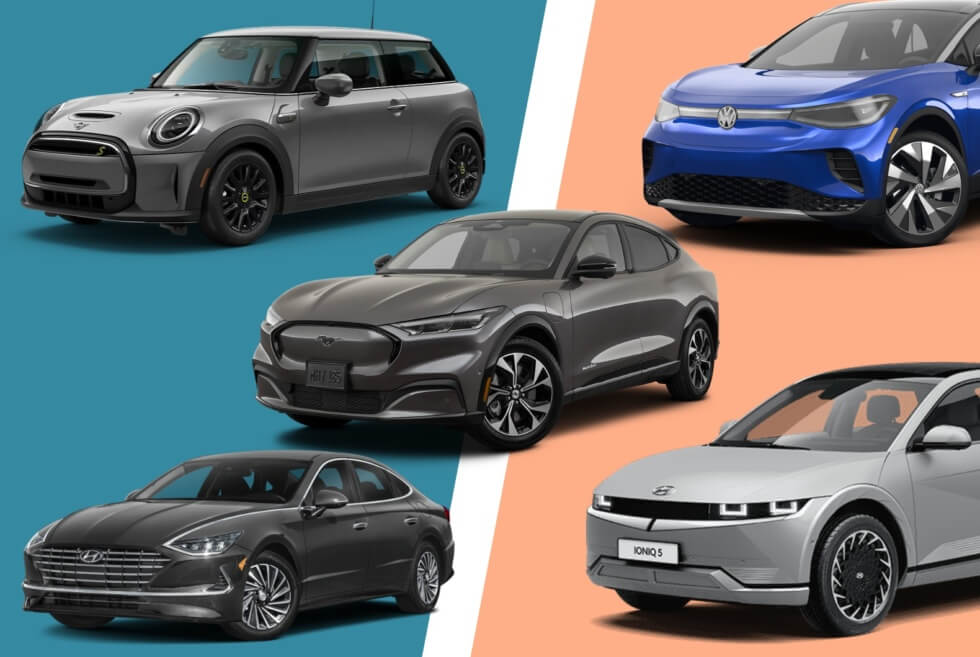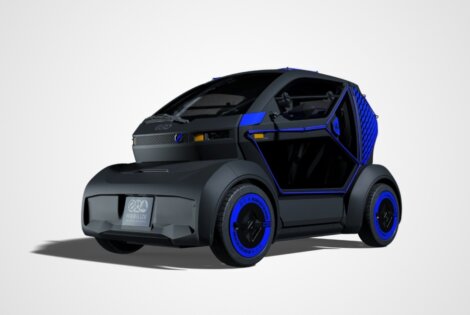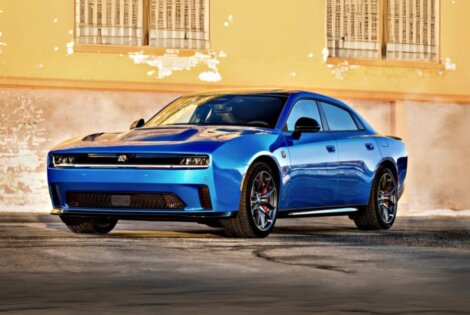With fuel prices skyrocketing, more people than ever are turning to electric vehicles.
There are now so many electric cars, trucks, SUVs, and vans to choose from that it’s hard to believe that only a decade ago, your options of electric vehicles were incredibly limited. Thanks to huge strides in modern technology, however, you have plenty of affordable options right at your fingertips.
Below, we’ve compiled a list of the best budget-friendly electric cars on sale RIGHT NOW. These models include some classics (including the much-loved Toyota Prius and Nissan Leaf) as well as some new entries to the market.
Check out each car on our list, and make sure to take the time to read our buying guide so you can know which electric car will give you the best bang for your buck!
New Electric Cars To Buy In 2025
Contents
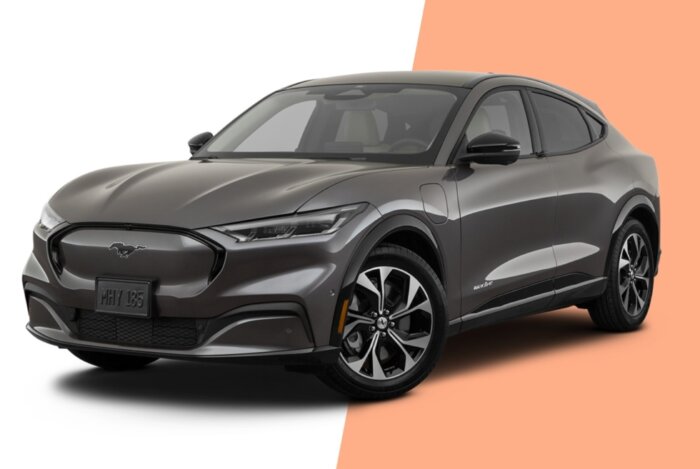
Ford Mustang Mach-E Select RWD
Go for full power with the Ford Mustang, a muscle car that packs a whopper of an electric engine. Unlike the OG Mustang, the Mach-E is designed a little taller and longer, giving you more room to stretch and shift while you drive. It’s available in both rear and all-wheel drive variants, letting you choose the model that delivers the range and power you want.
In terms of range, expect around 247 miles per charge, more than enough to get you where you need to go with ease. Its motor packs a powerful 266 hp and generates 428 ft-lbs of torque, allowing you to go from 0-60 in 5.2 seconds. For those who’ve always dreamed of owning a Mustang, but don’t want to pay ridiculous fuel prices, this is your dream car.
Specs
- Horsepower: 266 horses
- Torque: 428 pound-feet
- Battery: 68 and 8kWh options
- Range: 247 Miles

Hyundai Ioniq 5
When the Ioniq was first announced, it was among the most anticipated electric vehicles of its time. It may not be the most powerful on the market—just 168 hp and 258 ft-lbs of torque—but its 58 kWh battery pack delivers decent range, 220 miles per charge.
It’s built taller than your standard sedan, giving you enough rear storage space to transport camping, snowboarding, fishing, and beach gear as well as your passengers. The Vehicle-to-Load technology actually allows you to charge your devices straight from the car’s battery. Comfort is also a major factor in its design, so you get plush seats, an advanced console, and two built-in screens for on-the-road entertainment. For the price, you won’t find many better options!
Specs
- Horsepower: 168 horses
- Torque: 258 pound-feet
- Battery: 58 kWh
- Range: 220 miles

Mini Cooper SE
Mini is the brand most people think of when considering ultra-compact cars. Not only are they hyper-chic, they’re also among the most reliable on the market. So when Mini introduced the Mini Cooper SE, a four-seater, two-door hatchback powered by an electric motor, it was instantly catapulted to fame as one of the best EVs on the market.
It’s a bit heavier than most Mini Cooper models, but compensates for the extra weight by giving you a more powerful motor (181 hp). You won’t get insane milage—just 110 per charge—so you’ll probably be best served using it only as a vehicle to drive around town. However, you’ll love how peppy the car is, small enough to zip through traffic, park anywhere, and do it in style. Any Mini Cooper enthusiast will fall in love with this adorable little EV, which just so happens to be one of the most affordable on our list.
Specs
- Horsepower: 181 horses
- Torque: 199 pound-feet
- Battery: 32.6 kWh
- Range: 110 miles

Nissan Leaf
The Leaf was Nissan’s first entry into the EV market—and one of the first fully electric vehicles ever sold—and no one can doubt that it’s made a mark as one of the best in its class. In addition to a beautifully low price tag (compared to other EVs), it features a 149-mile range that is about average for the earliest-model, affordable battery-powered vehicles. Add in the $7,500 tax credit, and it’s one of the most budget-friendly vehicles on the market, hands down.
Sure, it’s not the most powerful car around (just 147 hp and 238 ft-lbs of torque), but it won’t leave you stranded by the roadside and it’ll definitely handle highways with ease. Plus, the interior comes with some user-friendly tech, including Apple CarPlay and Android Auto, an 8-inch infotainment system, and more. It’s even compatible with Level 2 and Chademo fast-charging to keep you driving all day, every day.
Specs
- Horsepower: 147 horses
- Torque: 238 pound-feet
- Battery: 40 kWh
- Range: 149 miles
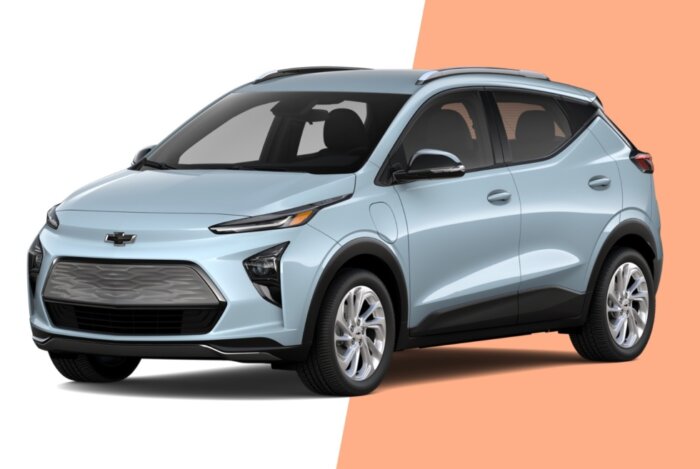
Chevrolet Bolt
Chevy’s Bolt is another ultra-compact car introduced to rival the Nissan Leaf, and though it’s not quite on par with its Japanese-made rival, it definitely has some benefits of its own that makes it a car worth considering. For starters, it’s got more power than the Leaf (200 hp and 266 ft-lbs of torque), a longer range (259 miles), and a more powerful battery (65 kWh). The price tag is only slightly higher but the value it delivers is undeniable, especially when you consider how easy and cheap maintenance is for the US-made car.
The redesigned interior features a 10.2 inch touchscreen, Apple CarPlay and Android Auto, and surprisingly comfortable seats even on the base model. Add to that a sleek, upgraded exterior, and you’ve got yourself a decent budget-friendly option that is likely to have a shorter wait time than the Japanese-made competition.
Specs
- Horsepower: 200 horses
- Torque: 266 pound-feet
- Battery: 65 kWh
- Range: 259 miles
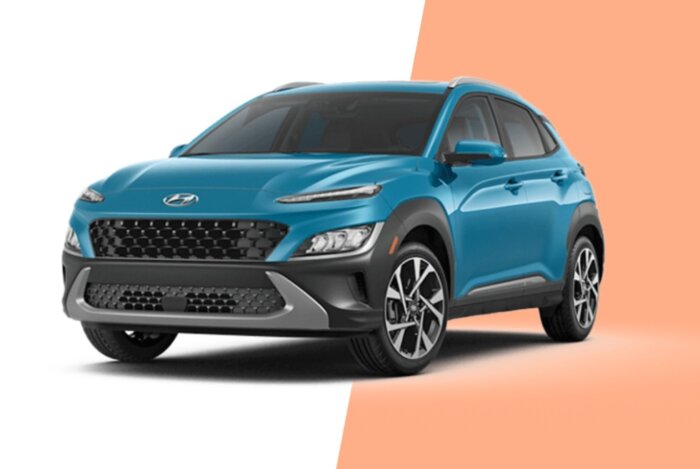
Hyundai Kona Electric
The Hyundai Kona is a popular sub-compact SUV that makes its mark by being reliable and affordable, and the EV model is no different. Even the base model has all the bells and whistles you could want for a comfortable ride and easy handling, along with an excellent price tag that you can’t help but love. On top of that, you can opt for the affordable upgrade to the Convenience package to add some sweet new features: power-adjustable seat, wireless charging, sunroof, seat heating, and more.
For its size, the engine is as powerful as you could ask for—201 hp, 291 ft-lbs of torque, and a 258-mile range on every charge of the 64 kWh battery. Once you add in the federal tax credit for buying an EV, you’ll find it’s one of the better-priced offerings on our list. If you’ve got a family or want the extra room to transport gear, it’s a great option.
Specs
- Horsepower: 201 horses
- Torque: 291 pound-feet
- Battery: 64 kWh
- Range: 258 miles

Kia Niro EV
What makes the Kia Niro so great? Well, to start off, it offers you plenty of power options: a full EV model, a plug-in hybrid, and even a standard gas-powered option if you prefer. It’s got a lot in common with Hyundai’s Kona, and offers similar functionality and competency to ensure you’re getting the best bang for your buck. The only real difference is in its look (which is a bit more outdated than the Kona) and handling (which is superior to the Kona).
The specs are the same—same horsepower, same torque, same battery—but the range is marginally less (239 miles vs. the Kona’s 251). The price tag is virtually identical, too, so if your local Hyndai dealership will take months to deliver on an EV, this Kia is a great alternative to consider.
Specs
- Horsepower: 201 horses
- Torque: 291 pound-feet
- Battery: 64 kWh
- Range: 239 miles
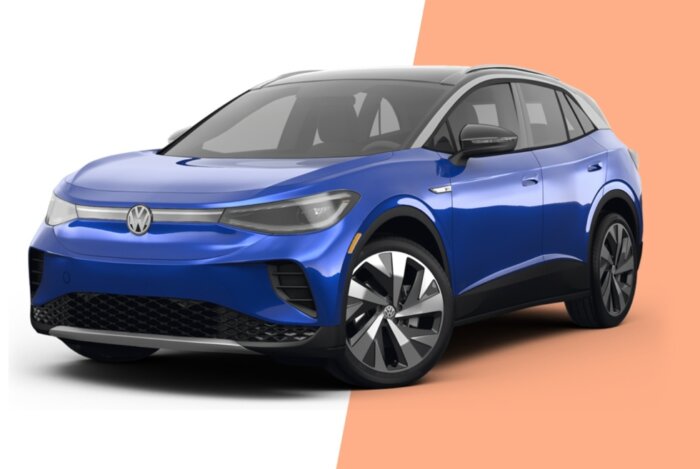
Volkswagen ID.4
You don’t pay rock-bottom bargain prices with Volkswagen’s electric SUV, but it’s well worth the slightly higher price tag for the German-made quality and reliability. The spacious cabin is sized just right for a family, with plenty of room for car seats and booster seats, as well as luggage. It packs plenty of tech, too—from wireless smartphone integration to gesture controls to activate and manage the built-in infotainment system.
It’s speedier than your standard EV SUV, handling more like a compact vehicle and drawing on plenty of power from its dual-motor setup. Its range isn’t anything overly exceptional—around 287 miles per charge—but with 201 hp and the option to switch to AWD makes it a decent option to consider if you’re planning to upgrade to an electric SUV.
Specs
- Horsepower: 201 horses
- Torque: 229 pound-feet
- Battery: 77 kWh
- Range: 287 miles

Hyundai Sonata Hybrid
Rather tan going for the pure-electric power, Hyundai used hybrid power for its Sonata, installing a 192 hp motor that extends its driving range significantly—up as high as 50 mpg in the city and 54 mpg on the highway. The front-wheel drive vehicle is sized to seat five, but does so comfortably, with all the interior bells and whistles you could want, including remote parking assist, Dynamic Voice Recognition, a large infotainment screen, and blind spot monitoring. Even the trunk has been upgraded and upsized, giving you more storage space for your luggage or gear.
Compared to most of the other hybrid cars on the market, the Sonata definitely hovers near the front of the pack. And you can’t help but love that affordable price tag!
Specs
- Horsepower: 192 horses
- Torque: 139 pound-feet from the gas engine, 151 from the electric motor
- Battery: 1.6 kWh
- Range: 45-50 mpg City, 51-54 mpg Hwy
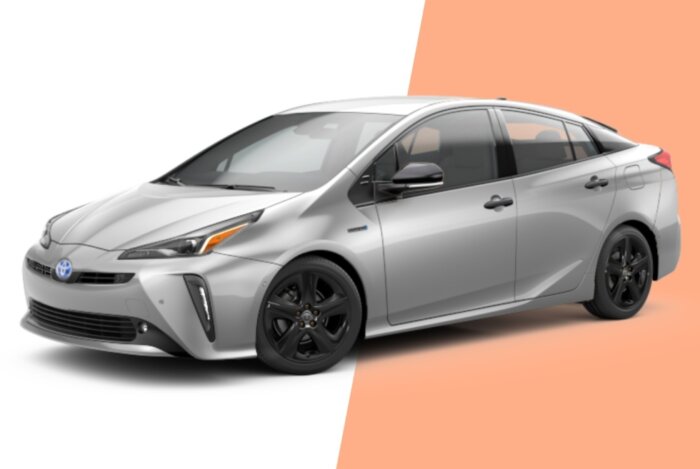
Toyota Prius
The Prius was Toyota’s first hybrid vehicle, and it set the bar fairly high for all the other car-makers that came after it. Unfortunately, due to great advances in EV technology, the Prius is now one of the lower-ranked hybrids due to its lack of power, meek acceleration, and less-than-luxurious cabin seating.
Make no mistake: the fuel economy ratings are still above-average, the cargo hold offers a surprisingly amount of storage room, and the integrated features are everything you could ask for. However, for only a slightly higher price, you can find other equally reliable EVs and hybrids (even Toyota’s own Corolla), many of which are far more readily available and have a shorter delivery time than the highly sought-after Prius.
Specs
- Horsepower: 121 horses
- Torque: 120 pound-feet
- Battery: 207 V lithium-ion and 202 V nickel-metal hydride
- Range: 51-58 mpg City, 47-53 mpg Hwy
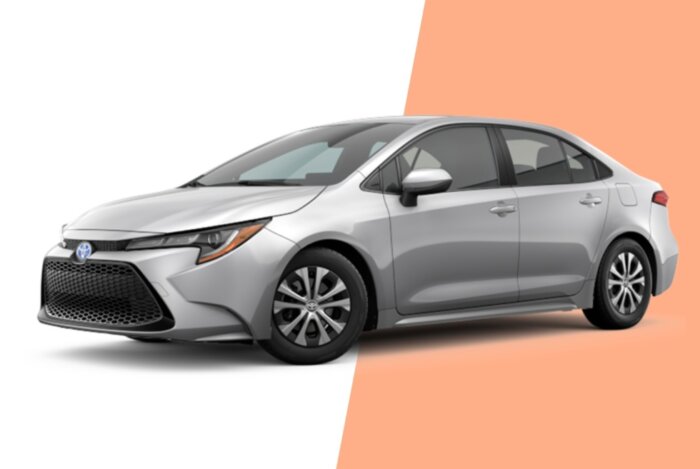
Toyota Corolla Hybrid
The Corolla is one of the most reliable of the small cars on the market, and the fact that Toyota is now offering a hybrid model just makes it all the better. Granted, it’s not the most fuel-economical car on the list (the regenerative braking system isn’t as efficient as the Prius), but it’s one you can drive for years trusting that it will keep up with anything you throw at it.
The integrated technology is simple but user-friendly, and Toyota has a reputation for manufacturing some of the safest cars on the market. The starting price is insanely budget-friendly—lower even than the Prius—but you can upgrade to add more luxurious features, turning it into a much more upscale vehicle than the base model. It’s light, zippy, and a suitable ride for anyone who wants to switch to a hybrid vehicle on the cheap.
Specs
- Horsepower: 121 horses
- Torque: 156 pound-feet
- Battery: 207 V lithium-ion
- Range: 53 MPG City, 52 MPG Hwy

Ford F-150 Lightning
Let’s be honest: this isn’t a car, it’s a truck. But when you look at how well it drives, you can see why it deserves to be on this list! Plus, the price tag isn’t even the highest on our list, so it’s an excellent option if you’re shopping for an EV.
The 98 kWh battery delivers up to 230 miles of range. Get ready to be blown away, because the 426 hp engine generates 775 ft-lbs of torque, can tow up to 5,000 pounds, and has a payload capacity of 2,000 pounds. On the interior, you get a 12-inch touchscreen, a 12-inch digital instrument cluster that gives you total control over the infotainment system, and a roomy cabin that will accommodate even the biggest, tallest users. You can’t go wrong with the F-150 Lightning, even if the truck still has a few kinks to work out!
Specs
- Horsepower: 426 horses
- Torque: 775 pound-feet
- Battery: 98 kWh
- Range: 230 miles
Electric Cars Buyer’s Guide
Before you buy an electric car, it’s worth taking the time to understand exactly what you’re buying, why it’s worth buying, and what factors need to be evaluated in order to make the right choice.
In this buying guide, we’ll cover all of that and more!
Let’s start off with the basics, the “why” you should even consider an electric car in the first place.
Benefits of Electric Cars
Lower running costs. While the price point on an electric vehicle (be it hybrid, plug-in, or full electric) is typically higher than their gasoline-powered alternatives, you end up saving money in the long run due to lower running costs.
Hybrids use less fuel than regular cars. Plug-in vehicles cost less to run, because electricity is significantly cheaper than gasoline. Removing a fuel engine from the equation also decreases maintenance costs exponentially.
Though the starting purchase price is higher, ultimately, it’s a “cheaper” vehicle in the long run.
Huge rebates and incentives. Most of the countries where electric vehicles are sold offer some sort of tax incentive or rebate to encourage people to spend a bit more on a “greener” vehicle, as part of a global effort to reduce emissions and control pollution. What this means is that buying an electric vehicle can actually be cheaper in the long run because A) the government will give you a tax credit to lower your yearly tax payment, or B) you get a cash rebate when you purchase the car.
Cleaner and quieter. Electric vehicles either reduce emissions (with hybrids) or eliminate them completely (with plug-ins and full electric motors), making them cleaner both for the environment at large and for your immediate environment (home, garage, driveway, etc.). They’re also quieter, meaning they generate less noise pollution in your neighborhood.
Drawbacks of Electric Cars
Long charging time. If you’re driving a plug-in or full electric vehicle, you’ll have to factor charging time into any trip. At home, you can charge your car overnight and enjoy your daily commute hassle-free. Some office complexes and parking structures offer specialized parking for EVs that include a plug-in for charging (at a fee).
However, when traveling around the country, you’ve got to make sure to include 15-30 minutes (at least) to charge the vehicle’s battery.
Less power. Though EVs tend to be punchier with the acceleration, a lot of the vehicles listed above have fractionally less power than their gasoline-powered models. This is a problem that is continually being addressed, and every new model increases power, but currently electric motors can’t generate the same amount of power.
Limited infrastructure. Not everywhere in the country has charging stations for EVs, which means you’re limited in where you can travel and for how long.
Types of Electric Cars
There are three types of electric cars currently on the market:
HEVs – HEVs, also known as Hybrid Electric Vehicles, utilize a gas-powered engine and electric-powered motor together. These are gas-forward, meaning they run on gas and have to be filled at a gas station like any regular vehicle, but the built-in electric motor will increase mileage and reduce fuel consumption.
Typically, these vehicles are less powerful than their standard counterparts, but the difference isn’t too significant. There is no battery to charge, though.
PHEVs – PHEVs, also known as Plug-In Hybrid Electric vehicles, also have both gas and electric-powered engines. However, the car will first utilize all the power that is stored in the charged battery, then switch to gasoline once the electric power runs out.
Typically, PHEVs have a short range (under 100 miles), but that’s not a problem for anyone who charges their battery nightly, commutes around town, and rarely travels beyond the vehicle’s range. These vehicles are often the ones to suffer from the most amount of power loss compared to gasoline-powered vehicles.
BEVs – BEVs, also known as Battery-powered Electric Vehicles, or just Electric Vehicles (EVs), are the true definition of “electric car”. They have no gasoline engine, only an electric-powered motor operated by the built-in battery. They can only be charged by plugging them in, but their range is typically significantly longer than the PHEVs because the battery packs are also significantly larger. They are also the most expensive electric vehicles on the market.
Factors to Consider
When shopping for an electric vehicle, here are the factors you should consider:
Range. When talking electric vehicle “range”, typically that’s referring to how far a plug-in hybrid or battery-powered electric vehicle can run on a single charge before running out of battery life. Typically, lower-end hybrids will have a range of 50 to 100 miles, but the higher-end EVs can get upwards of 200 or even 300 miles on every charge.
However, take note that a number of factors can include the EV’s range, including:
- Speed – Some vehicles charge better at lower (city) speeds (thanks to regenerative braking), while others manage better range when driving on the highway at high speeds.
- Battery age – The older your battery, the more the internal energy cells will deteriorate. Thankfully, most batteries have a 100,000-mile/8-year warranty, so you can get many years of reliable use before the battery starts to show signs of aging.
- Weather – Extreme cold will prevent your battery from holding its charge. High-heat environments will force you to run your AC, which drains the battery faster.
- Charge – If you’re using a rapid-charger, typically you can get up to 80% charge (in the 20 or 30 minute rapid-charge window). That means you’ll only get about 80% of the “max range”. Also, batteries are typically built with protection to keep it from ever reaching full 100% charge. This is done to prevent over-charging.
Fuel economy. This refers to your mileage when driving a hybrid vehicle (gas-powered with built-in electric motor). Mileage on a hybrid will always be better than on the gas-only vehicles, but just how economical each vehicle is will range from model to model and brand to brand. It’s a critical factor to consider when vehicle-shopping, though. That way, you can figure out how much you’ll ultimately save on fuel costs, so you can know how long the vehicle will take to “pay itself off”.
Tax credits and incentives. Most countries offer some sort of tax credit or incentive for those buying EVs, as a means of encouraging “greener” vehicles. The amount will vary from state to state or province to province—even some cities will offer unique incentives—but you may find that these additional offerings ultimately make it cheaper to buy a hybrid vehicle than the gas-powered models.
Maintenance costs. Maintenance is a factor to consider with any vehicle you buy. In a perfect world, you want a vehicle that runs well, lasts for years, and gives you as few mechanical issues as possible.
EVs tend to be much cheaper on maintenance costs year-to-year because there is no gas engine, so no oil changes are needed, and there are no water pump, fuel pump, exhaust system, and other parts required to run a gasoline engine. However, when the time comes to replace the battery, they can be pricey—up to $22,000 for a Tesla Model S!
On the flip side, hybrid vehicles require regular maintenance for their gas engine, but there are no costly battery replacements down the road. It’s a trade-off that will need to be factored into your decision as to what type of EV to buy.
Handling. There’s no denying that switching from gas to electric motors changes the way the vehicles handle. EVs tend to deliver power instantly even when stopped, and they tend to be much quieter and deliver a smoother ride. On the other hand, if you need a lot of power (such as when driving a truck), EVs just can’t quite deliver.
With many EVs (like Teslas, for example), simply removing your foot from the accelerator will cause the car to slow, and there’s no real need to use the brake. It takes some time to get accustomed to the way EVs handle.
Gas-forward hybrids operate like any standard vehicle, though some users have noted that they feel a noticeable loss in power when accelerating quickly. This is because it takes the car a moment to regulate its use of electric and gas power, so these hybrids tend to be fractionally less powerful than their purely gas-powered models.
Delivery time. This is one of the biggest drawbacks of EVs currently. Due to the shortage of a variety of metals, the manufacturers of the microchips used in the vehicles’ computing systems and the electric batteries are struggling to match the demand. Even the car-makers themselves are having a hard time overcoming supply shortages to make sufficient vehicles to equip with electric motors.
Gone are the days when you can simply drive an EV off the lot. Typically, you have to place the order (online or in the dealership), and delivery time can be anywhere from 4 to 18 months (or longer, in the case of Tesla’s Cybertruck).
Home charging capabilities. With plug-in hybrids and EVs, you have to have a charging station set up in your home in order to charge the vehicle overnight. Most EVs will come with their own charging system, which you can connect to your home’s electrical grid (usually in the garage or covered driveway) to allow you to charge your vehicle.
But not all complexes and condos will allow EV charging stations. It’s worth checking the bylaws of your residence or neighborhood to ensure it’s permitted. And you definitely want to call in a professional electrician to do the work of hooking up the charging station correctly.
Charging station availability. You may be able to charge every night at home, great for those work days when you’re just driving around town. But what if you want to take a weekend trip away from home? You’re going to need to find charging stations along the way, just like you’d need to find a gas station.
The U.S. and Canada both have at least a moderate infrastructure in place, providing ample charging stations all across the country (both east-west and north-south). However, there are still many regions of the country that don’t have charging stations, which makes it a risk to drive through those areas.
(Thankfully, the U.S. Department of Energy has an interactive map that lists the majority of the charging stations around both the U.S. and Canada, as well as in other countries around the world.)
Warranty. All new vehicles come with some form of warranty, though for EVs, they’re typically broken down into three types:
- Battery. Federal regulations mandate that all EV batteries are covered by a warranty for 100,000 miles or 8 years.
- Powertrain. This includes all the mechanical components (engine, transmission, etc.). Warranties will vary from vehicle to vehicle and manufacturer to manufacturer, though you can usually expect around 5 years/60,000 miles.
- Comprehensive. This includes the cost of replacement parts and the labor needed to cover the repair/replacement of those parts. Typically, comprehensive coverage will last around 3 years/36,000 miles, though some car makers offer more.
New vs. used. Used EVs may be a great option to consider if you need an electric vehicle now and don’t want to wait the (long) months until a new vehicle is available for delivery. Fair warning: used EVs are no longer significantly cheaper than new vehicles, due to very high demand and low availability. In fact, some used EVs actually sell for more than brand new because people want to get their hands on an EV now rather than waiting.
There are all the usual risks associated with buying used, though, including hidden damage, poor vehicle condition, no warranty coverage, outdated technology, and higher maintenance costs.
Price. Last, but certainly not least, price is a factor you’ll want to take into account. The fact that you’re on a page titled “Best Cheapest New Electric Cars” proves that you’re a price-conscious shopper who wants to get the best-quality car at the most affordable price. That means you’ll likely carefully compare the price tags of all the vehicles above in order to find the one that gives you the most of what you want while still being within your price range.
The good news is that EVs are no longer the ultra-expensive luxury they once were. Now, more and more electric vehicles are being offered at an affordable price tag, allowing you to drive out of your dealership with a car that will save you on fuel and maintenance costs—and, best of all, make your corner of the world a little bit “greener”.


